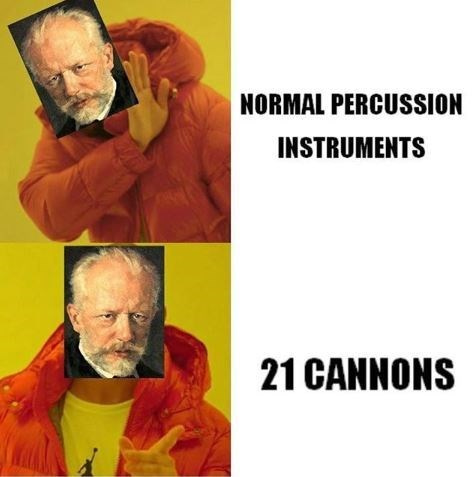Interested in listening to classical music that's packed with intense energy and passion?
If so, the works of the Romantic period are the best ones to start with.
This period in music history (1820-1910) was one of the most innovative and expressive of all time. The lyrical melodies and passionate songs of the Romantic period continue to mesmerize music lovers even to this day.
For your listening pleasure, I've included seven pieces by seven famous Romantic composers.
Rachmaninoff, Saint-Saëns, Schubert, Tchaikovsky, Johann Strauss, Wagner, and Dvorak are all on this list!
If you're wondering where Beethoven is, I decided to include him in my Classical period article.
Since Tchaikovsky is my favorite composer, I was tempted to include all of his work in this list. Lucky for you, I decided against it.
Don’t worry though, there will definitely be full-length articles on masterpieces like Swan Lake and the 1812 Overture in the future 😉

^If you don't get this meme, go listen to the 1812 Overture and crank your volume up. NOW.
In the meantime, I’ll start off by giving a quick background on the characteristics of Romantic period music.
A more comprehensive overview is featured in my Ultimate Beginner’s Guide to Classical Music, which you can start reading right here.
If you’re already familiar with the characteristics of Romantic era music, no problem. Just skip the next section and start enjoying the list below!
Characteristics of Romantic Period Music
The Romantic movement in Europe encompassed not only music, but literature and other forms of art as well. The unifying factor was an emphasis on emotion and the individual that underlined all Romantic period art.
As such, the main three elements of Romantic era compositions are emotion, emotion, and more emotion.
Romantic period composers started using more dissonance to build dramatic tension in their works. Also, the orchestra expanded by bringing in instruments to play in higher and lower ranges.
All of this was designed with one goal in mind: allow composers to better express the highs and lows of emotional experience.
Longer compositions were quite common in the Romantic period of classical music. As such, recurring themes called a leitmotif or idée fixe were used to unify a piece throughout all its different movements.
You’ll find examples of some of these in the works listed below.
The emotion in these Romantic era pieces is intense - Whether you want to celebrate your victories or weep over your defeats, the music of the Romantic period is there to keep you company.
Now, let’s get listening!
The Top 7 Pieces of Romantic Period Music
Tchaikovsky: The Nutcracker, Op. 71, TH 14: Miniature Overture
A two-act ballet, The Nutcracker, used Tchaikovsky's score. This "fairy" ballet is an adaption from E. T. A. Hoffman's story, The Nutcracker and the Mouse King.
The Nutcracker has enjoyed tremendous popularity since the late 1960s, and the ballet's score is used in many film adaptations of Hoffmann's story.
The last of Tchaikovsky's three ballets, The Nutcracker was first performed in 1892. The ballet's fairy tale setting was perfect to experiment with the celesta — a new instrument that Tchaikovsky discovered in Paris.
The celesta, while not heard in this specific composition, is most prominent in The Dance of the Sugarplum Fairy, a piece that comes later in the ballet.
A Christmastime staple in the United States, The Nutcracker serves as an incredible source of revenue for ballet companies across the nation. On average, it brings in 48% of all yearly revenue for US-based ballet companies!
Wagner: Die Walküre, Act III: Ride of the Valkyries
The Ride of the Valkyries is one of Richard Wagner's best-known pieces.
It is a part of the Ring of the Nibelung, which is a set of four German musical dramas composed by Wagner.
Like many of his other compositions, several years passed between the completion of the Die Walküre score and its first performance. The German composer began composing Die Walküre in 1854 and finished the full orchestral score in 1856.
The completed opera was first performed at the National Theatre Munich in 1870, but without Wagner's consent.
It was only after the Ring was performed in Bayreuth in 1876 that he lifted his self-imposed ban and went on to conduct it himself in London in the year 1877.
Even though it was part of the Ring of the Nibelung series, Die Walküre was more popular than the other Ring dramas. It continues to be performed independently even today.
There were several films that used music from Wagner's Ride of the Valkyries in their soundtracks. Some of these include The Birth of a Nation (1915), What's Opera, Doc? (1957), and Apocalypse Now (1979).
Saint-Saëns: The Carnival of the Animals, R. 125: VII. Aquarium
Saint-Saëns composed The Carnival of the Animals as a humorous musical suite in 1886. The French Romantic composer composed this ‘grand zoological fantasy’ in 14 movements with 11 instruments.
Though The Carnival of the Animals eventually became one of his best-known works, Saint-Saëns regarded it as something light-hearted and fun. He didn't think it was anything to take too seriously.
Following his two private performances of the Carnival, Saint-Saëns placed the suite under lock and key!
Saint-Saëns was adamant about Carnival not being published during his lifetime. So much so, he even added a note in his will to mention that it only be released posthumously.
True to his wish, The Carnival of the Animals was published in 1922 after his passing in 1921.
The piece eventually found immense popularity. Even today, music teachers from all around the world continue to enthrall their students with the music of this beautiful suite.
Rachmaninoff: Piano Concerto No. 3 in D Minor, Op. 30
A leading figure of Russian music, Sergei Rachmaninoff’s compositions were the last of what was left of the Romantic Style in Russia.
Rachmaninov composed the Piano Concerto No. 3 in 1989 and dedicated it to Josef Hofmann.
The legendary composer's mastery of the piano stunned audiences wherever he performed. His technique was so incredible that he held his audiences spellbound by his skill and style.
The intensity and level of difficulty of Piano Concerto No. 3 has created immense respect for the piece. Some pianists even fear trying to attempt it lest they do injustice to Rachmaninov's brilliant composition.
Conductor Joshua Weilerstein even went as far as to call the third and final movement "13 to 14 minutes of sheer terror for every pianist on earth."
Rachmaninoff wrote Piano Concerto No.3 in D Minor for a US tour. He had limited time to prepare and present it. To make up for the short duration Rachmaninoff used a silent keyboard to rehearse the piano part at the time of his crossing to the United States.
Considered Rachmaninoff’s masterpiece, Piano Concerto No.3 is the largest and the most satisfying of all his concertos.
PS - If you only listen to one part of this work, listen to the third movement. Click here and get ready to have your socks knocked off!
Schubert: Ave Maria, Op. 52 No. 6, D. 839
Though this piece is now called Ave Maria, Schubert never actually wrote a piece called “Ave Maria.”
Yes, you read that right.
The work we commonly refer to as “Ave Maria” is actually called Ellen’s Third Song. It’s part of a series of compositions Schubert wrote as he put music to the story of The Lady of the Lake, a popular narrative poem by Sir Walter Scott.
In Ellen’s Third Song, the character Ellen sings a prayer to Mary, asking for her help. The prayer opens with “Ave Maria,” which is Latin for “hail Mary.”
“Hail Mary” is the intro phrase to one of the most popular Catholic prayers.
In the opinion of music experts, it is most likely the presence of the words ‘Ave Maria’ in the intro of Schubert's Ellen’s Third Song that led to the great composer's melody being adapted as a famous de facto Catholic piece.
Written in 1825, Schubert's work we now call Ave Maria continues to be one of the world's favorite compositions.
It received even more immense love and admiration when it was made a part of Walt Disney’s Fantasia in 1940.
Johann Strauss II: An der schönen blauen Donau
The Blue Danube, or An der schönen blauen Donau in German, is a waltz by Austrian composer Johann Strauss II, who was famous for his Viennese waltzes and operettas. He created this dance piece in 1867.
It is Strauss’ most famous composition, and the one that earned him the name of the "Waltz King." Of the 500 dance pieces that Strauss created, more than 150 of them were waltzes.
The best of Strauss’ many dance pieces, The Blue Danube was originally written as a choral piece. There are five waltz themes in the composition, each intricately linked with the best dance music of the Romantic era.
A specific act by the great German composer, Johannes Brahms, stands out as a testament to the attractiveness and magnetism of Strauss’ works.
When Brahms signed an autograph for Strauss' stepdaughter, Alice, he wrote down the first bars of The Blue Danube. What's more interesting however, is what he wrote next to them.
Right next to the bars of music, the great composer added, "Leider nicht von Johannes Brahms" - Unfortunately not by Johannes Brahms!
Dvorak: Symphony No. 9, From the New World
Do you know which tape recording accompanied the first lunar landing? It was Dvorak's Symphony No. 9.
During the Apollo 11 mission in 1969, Astronaut Neil Armstrong carried a tape recording of Symphony No. 9 with him.
Popularly known as the "New World Symphony," Dvorak's Symphony No. 9 is his most popular symphony and one of his best-known works. Not only was it a huge success at the time it debuted, it continues to be widely performed even today.
Dvorak wrote this piece after he moved to New York from Europe. He was highly influenced by American music and culture during his several years of stay in America.
Students of music history and style will see the American influence very clearly evident in Symphony No. 9. However, Dvorak was also greatly influenced by the style and techniques used by Beethoven and Schubert.
From the New World premiered at Carnegie Hall in 1893. This symphony marked one of the greatest public triumphs in Dvorak’s music career.
Conclusion
The Romantic period of classical music produced some of the most thrilling, passionate, and beautiful works of all classical music.
Trust me, this list could easily be MUCH longer. I've just limited it to these seven pieces and composers in order to show you the diversity of the Romantic era.
Because the Romantic period produced some of the best examples of classical music, I'll soon be writing more articles that go in-depth about specific works. Ballets like Swan Lake and The Nutcracker are simply too beautiful to be looked over.
To stay up-to-date on when those articles come out, be sure to join my mailing list below.
And if you enjoy the suggestions on this list, you'll love my other articles on the best pieces from the Classical and Baroque periods.
Talk soon, and in the meantime, happy listening!
-Evan
